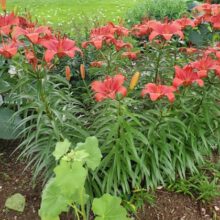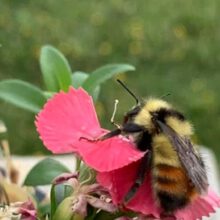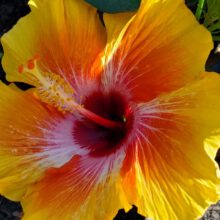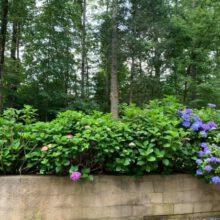Feeding Insects In Your Garden
Different insects (larvae) see your garden plants as a tasty snack. The easiest way to combat them is by luring natural enemies, such as ladybugs, birds and hedgehogs, into your garden.
Tips against feeding insects.
1. Make your garden attractive to the natural enemies of pests, such as ladybugs, hedgehogs and birds. Provide varied planting, nesting boxes and shelters.
2. Remove affected branches or leaves, such as aphids. Do not throw it on your compost pile, but throw it at the organic waste. Otherwise, bring the bugs back to your garden later. Insects on young shoots can be removed by hand or with a strong jet of water.
3. With garlic or nettle, for example, make your own environmentally friendly alternative to chemical pesticides against insects.
These are common feeding bugs:
Below will show you the symptoms along with the insect.
- Round bites from the leaf margin: Yew beetle (grooved lap weevil).
- Small round holes on leaf and base of herbaceous plant: Earth caterpillar (larva of various moths).
- Lawn that possess withered grass and loose turf: Larva of cockchafer.
- Lawn that is round bald spots and discoloration: Larva of crane fly.
- Messy holes and damage to new shoots: True bugs.
- Rhododendron does not bloom; yellow spots on top of leaf and brown rusty spots on the underside: Japanese fly (bug type).
- Boxwood that possess dead leaves, bare twigs, leaf skeletons and spins: Boxwood moth.
Aphid.
You recognize aphid by the dirty, sticky spots on a plant. The animals live on plant juices. They secrete the sugar (honeydew) in it like a sticky stuff. Green and black aphid often sit on young shoots, other aphid prefer to eat from the trunk or branches.
Mites.
Mites leave dull leaves, sometimes with spider threads on the underside. They are small arachnid bugs that are common on conifers and lime trees.
Ladybugs and bantam chickens.
Aphid are on the menu of ladybugs and lacewings. If these beneficial insects do not automatically come to your garden, buy bags with larvae and hang them in the affected bush or plant. They will spread quickly in search of an aphid meal. A larva can eat up to eighty aphids a day! The larval sacs are especially useful shortly after you have identified the first aphid.
Yew beetles.
You can easily remove caterpillars by hand. Yew beetles shelter at the bottom of boards. If you put a few boards between the affected plants, you can collect the beetles in the morning. Bantam chickens like to eat yew beetles, but also young plantings: so only let them loose in a garden with mature plants. Finally, you can fight these beetles naturally with special nematodes, which are available in garden shops and via the internet.
Nematodes versus grubs.
Other nematodes are good pest control agents if you suffer from earthworms, leatherjackets or grubs. Leatherjackets (larvae of crane flies) in your lawn have little chance if you cut the grass short and do not spray when the crane flies lay their eggs; that is late August/early September. Scarifying or puncturing also helps against leatherjackets and grubs: the animals do not tolerate disturbance.
Boxwood moth.
The caterpillars of the boxwood moth eat boxwood shrubs bare before they emerge. The moth comes from Asia and causes more and more damage in the Netherlands. Pesticide treatment is usually unsuccessful and dangerous to bees. From April, pay close attention to be able to take timely action and protect your boxwood.
Be alert for signs such as spins, feces, worms or caterpillars in your box. Look deep into the plant at the lower trunks and wrist of neighbors with a boxwood to see if they already have problems. Early treatment requires less pesticide and more guarantee of success. You are usually late when you see dead leaves, bare twigs and leaf skeletons with silk.
Remove caterpillars and pupae by hand and cut out the spins. It is better to completely remove or cut off heavily affected parts of the bush. Dispose of the branches in a sealed bag or container, but do not throw the affected boxwood at the VGF. The caterpillar, or the butterfly if the box is long enough, can escape, and before you know it, the animal will spread to other locations.
Spray with a natural extract.
Garlic, soy and onion extracts, or essential oils of vegetable origin, are environmentally friendly alternatives to chemical pesticides. You can make ‘garlic tea’ like this: cut 5 garlic bulbs into pieces, pour 1 liter of boiling water over them and let it steep for 24 hours. Strain the mixture, add 3 liters of water and spray the tea over the plant daily. Keep this up for 5 days.
Nettles against insects.
With a nettle extract you can protect fruit trees and vegetables against insects such as aphid, fleas and spider mites. The product is officially approved and you have enough nettle soup in a few steps to remove pests in your vegetable garden in an environmentally friendly manner. Mix 75 grams of young nettle leaves with 1 liter of drinking water and let it steep at 20°C for 3-4 days. Dilute the product 5 times before using it.
Effective home remedies with green soap.
You fight aphids, thrips and whitefly in an environmentally friendly way with home remedies containing soft soap (and often spirit). You can buy these kinds of remedies ready-made in garden centers. Then it says ‘potassium salts of fatty acids’. An example recipe to make yourself is a tablespoon (maximum 30 grams) of green soap in a liter of water with a dash of spirit. You spray this every day for a week in the evening (never in full sun!) On the top and bottom of the leaves of affected plants until it drips off. Do not spray into opened flowers.
Potassium salts of fatty acids are toxic to some insects (both beneficial and harmful) and to aquatic invertebrates. Therefore, do not use this type of equipment next to ditches or ponds and do not throw leftovers in the garden or on the street.
Resources in the store.
Rock flour (also known as lava flour or basalt flour) is available in the store. This powder ensures that leaves remain dry, so that larvae have less chance. Water glass (potassium or sodium silicate) has been banned against insect insects in your plants since June 2018. Rapeseed oil has been authorized since that date. If you spray it on plants with aphid, it clogs the aphid’s breathing tubes. Do not use the oil if it is above 25 degrees Celsius outside, or in bright sunlight. Then it can damage the plants. Prevent beneficial insects (e.g. bees or ladybugs) from being hit by the spray liquid.
Chemical control: Is it necessary?
If the above tips and tricks don’t work, you can choose chemical pesticides. Only buy products with an authorization! By following the instructions exactly, you prevent environmental damage.
In the greenhouse against whitefly.
Only in the greenhouse can you use an insecticide based on the micro-organism Paecilomyces fumosoroseus against whitefly on tomatoes, cucumbers and floriculture. It contains fungal spores that attach to the insect skin, germinate, penetrate and grow there. The flies are dead after more than a week. It works best when it is warm and humid.
Pyrethrine: natural insecticide.
Pyrethrins are natural insecticides made from chrysanthemum leaves. The substance acts on the nervous system of insects that come into contact with it and quickly leads to paralysis. Pyrethrins decompose quickly in the sun and can therefore be exhausted before the insect is eliminated. This is an advantage for the environment: it reduces the chance that beneficial insects will suffer, but it makes the substance less effective. Therefore the fabric is mainly sold in the following variants:
- Pyrethrin with rapeseed oil. The oil softens the insect’s armor to allow the pyrethrin to act more quickly. It is used against spider mites, thrips and aphids, among others. To prevent insects from becoming resistant, you should not use it more than 4 times a year.
- Pyrethrine with piperonyl butoxide. This substance inhibits the breakdown mechanism in the body of insects and thereby strengthens the effect of the pyrethrin. But this also increases the risk of damage to beneficial insects.
- Pyrethroids are the artificial imitation form of pyrethrins. The artificial form is less likely to break down. An example of this: deltamethrin. It should only be used against leaf-eating beetles, caterpillars and aphids, up to 2 times a year. It is toxic to aquatic life, so don’t use it near ponds or ditches.
- All pyrethrins and pyrethroids are contact insecticides. They only harm insects that come into direct contact with it. So be careful not to hit useful insects such as bees and bumblebees with it.



